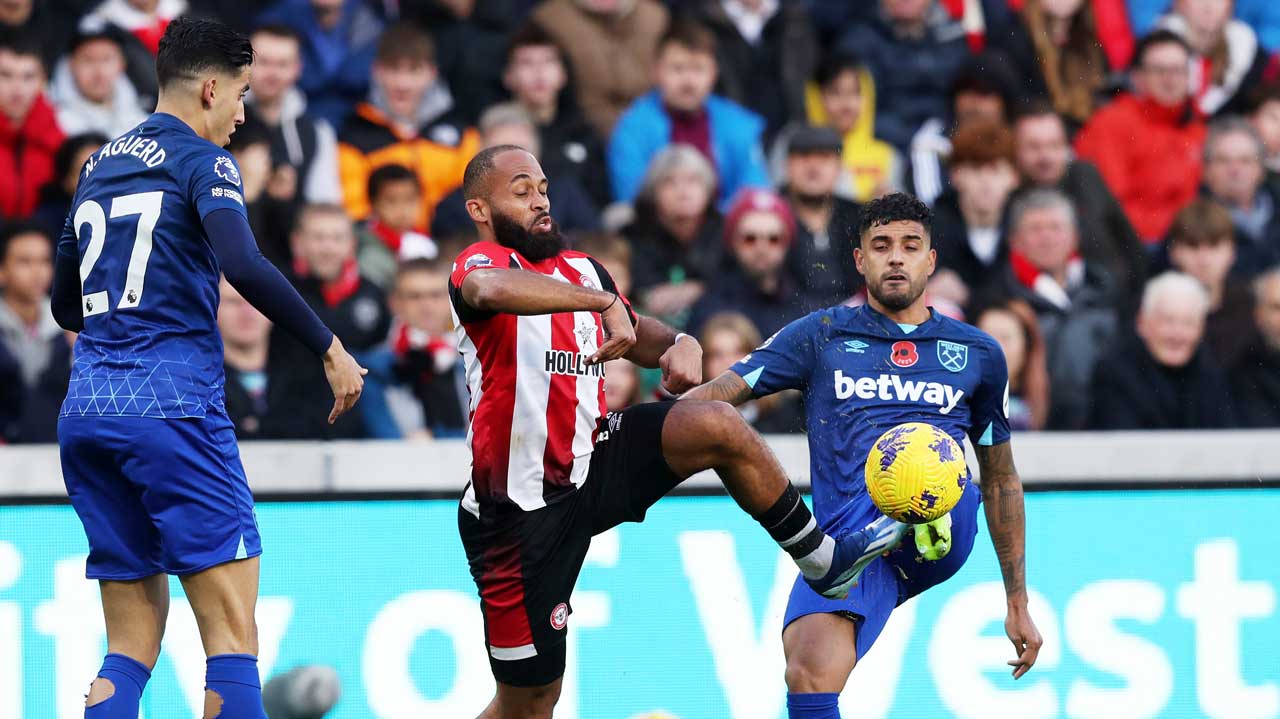Formed by Hammers supporters Jack Elderton and Callum Goodall to offer their fellow fans in-depth but accessible analysis of their team and its players, Analytics United use performance analysis and data to examine how Thomas Frank’s Bees could approach tonight’s game, and how David Moyes’ West Ham United might get the better of them...
Brentford came out on top when these teams last met at the Gtech Community Stadium in November and Thomas Frank will be hoping his side can secure a repeat at the London Stadium while David Moyes is in need of arresting the slide with a first win in seven for West Ham. To explore what we might see in this match, we can revisit that first fixture and look at the key elements that went into Brentford’s win to establish a plan for an improved West Ham result this time around.
The first match was a classic game of two halves as Moyes’ side were much stronger in the first period whilst the Bees improved dramatically after the break and dominated the second half. Although Brentford went ahead early on through Neal Maupay, West Ham caused Brentford huge problems in the opening half an hour with an aggressive man-to-man press, recording just 7.3 PPDA (Passes Allowed Per Defensive Action) between minutes 16 and 30 – 9.42 less than the season average of 16.72 which has been the second least intense press in the Premier League this season.

Usually, Moyes’ teams will sit off rather than press aggressively as the defensive system looks to block up the central zones, force the opposition wide, and incentivize crosses that players like Kurt Zouma and Tomáš Souček can head out of the box to launch counter-attacks. But, working from a 4-4-2 formation with Michail Antonio and Bowen partnered up front and supported by Saïd Benrahma and Kudus on the flanks, West Ham were far more eager to interrupt Brentford’s build-up.
This is, in part, because Brentford were without Ivan Toney, and therefore lacking the kind of quality hold-up that they can usually rely on should they need to go long, and because Rico Henry was also missing which forced Frank to use Vitaly Janelt at left-back and deploy something of a 4-2-4 in possession with Onyeka moving forward from midfield to augment the frontline and stop Maupay from being left 2v1 against the centre-backs.
With 4-2-4 playing 4-4-2 there was obviously the opportunity for man-to-man pressure to be initiated across the pitch and West Ham took this opportunity with Bowen and Antonio harassing the centre-backs, whilst also trying to cut passing lanes into Brentford’s double-pivot of Christian Nørgaard and Mathias Jensen, and Kudus and Benrahma stepping forward to close down full-backs Janelt and Kristoffer Ajer. This led to both West Ham goals as Benrahma intercepted a pass to Ajer before the first and Antonio won the ball off Nathan Collins which started a chain of set-pieces that eventually brought the second.

With West Ham in the ascendancy, Frank was forced to change and he instructed his side to move to a 3-2-5 shape rather than the 4-2-4 they had started with. Yoane Wissa came inside and Bryan Mbeumo and Janelt became wing-backs with Ajer completing the back three alongside Ethan Pinnock and Collins. This change of system completely flipped the game on its head as Moyes’ team were suddenly too narrow in their press (4v5) and equally overloaded on the backline (5v4) with the wide players, Janelt and Mbeumo, working incredibly hard on the flanks to impact both ends of the pitch.
West Ham took too long to respond to this change and were unable to track these two wide men without widening their shape too much and opening space for Jensen to impact the game in the centre. But despite losing the first encounter, there were lessons to take that should benefit Moyes’ team in the return fixture. The most significant of these is how effective man-to-man pressure was against Brentford’s build-up. Although Brentford eventually found a workaround and took advantage of the rigidity in West Ham’s shape, Moyes might be wise to bend his system to enable continuation of that pressure from the first fixture. In players like Edson Álvarez and Emerson he should have the on-pitch flexibility to do this.
On the other hand, Toney has now returned for the Bees and this completely transforms their ability to escape pressure and retain possession from more direct play. It’s no surprise that Brentford’s long pass percentage increased from the season average of 13.92% to 23.17% in his first game back against Spurs last month. The Bees’ average passes per possession has dropped significantly, from hovering just below five down to less than three, which indicates their increased willingness to be direct with Toney back in the side.
Whatever Moyes chooses to do, whether that be pressing as intensely as in the opening half an hour of the first fixture or sitting off a little more to stop Toney from being able to operate in space, West Ham will need to get top performances from the centre-backs in the duels. Taiwo Awoniyi was afforded too much room and was able to physically dominate too easily at the City Ground last time out and the centre-backs will have to step up a level to compete with Toney who is a similar, if a little more complete, striker.
West Ham are capable of getting a result today. Combining those past experiences with improved collective and individual levels will be key to securing that.
*The views and opinions expressed in this article are those of Analytics United and do not necessarily reflect the views opinions of West Ham United.

